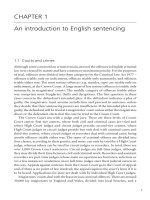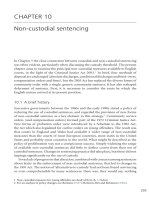Special sentencing powers
Bạn đang xem bản rút gọn của tài liệu. Xem và tải ngay bản đầy đủ của tài liệu tại đây (3.05 MB, 21 trang )
CHAPTER 12
Special sentencing powers
This chapter deals with three sets of sentencing powers for particular groups of
offender. It begins with the sentencing of young offenders under the age of 18, deals
briefly with young adult offenders aged from 18 to 21, and then concludes with
the various powers for dealing with mentally disordered offenders. In respect of
each group, we will consider the justifications for separate sentencing powers, and
the extent to which the rationale for special powers carries through into sentencing
practice.
12.1 Young offenders
For almost the whole of the last century there were different sentencing procedures
for younger offenders. Those aged under 17 (after the Criminal Justice Act 1991,
under 18) weredealtwith in differentcourts,formerly called juvenile courts and then
renamed ‘youth courts’. There is a considerable literature about the development
of sentencing policy in respect of young offenders,
1
whereas the discussion here is
necessarily briefer.
12.1.1 A short history of juvenile justice
Ever since 1933, the law has laid down that, in dealing with a juvenile offender, a
court ‘shall have regard to the welfare of the child or young person’.
2
This welfare
ideology reached its apotheosis in the Children and Young Persons Act 1969, which
sought to ‘decriminalize’ the juvenile court by regarding the commission of an
offence as merely one way in which the court’s powers to intervene for the welfare
of the child could be activated. The legislation contemplated that children under 14
would be dealt with outside the criminal courts, and those aged 14–16 would only
rarely be taken to court.
3
The 1969 Act failed, however, to resolve the long-standing
tension between the welfare ideology and the tougher, punitive approach. In 1970
1The leading legal text is Ball, McCormac and Stone (2001). For surveys see Newburn (2002), Ball
(2004) and Bottoms and Dignan (2004).
2Children and Young Persons Act 1933, s. 44(1). 3 Bottoms (1974).
359
360 Special sentencing powers
there was a change of government, and some sections of the 1969 Act were never
implemented. Much of its welfare ideology remained largely at the level of rhetoric:
its foundations had lain in the belief that juvenile courts should work through
and with the family, and should be seen chiefly as welfare-providing agencies. But
some magistrates were unhappy with the greater power and discretion it bestowed
upon social workers, and campaigned vigorously against the changes. The 1970s
saw an expansion in the cautioning rather than prosecution of juveniles, but it also
saw an unprecedented increase in the imposition of custodial sentences on young
offenders. The struggle between welfare and punishment, between local authority
social work departments and the magistracy, was joined in 1980 by the government,
which issued a White Paper proclaiming a tougher approach. Tougher regimes were
introducedintosome detention centres,onan ‘experimental basis’, and the Criminal
Justice Act 1982 restored to the magistracy some of the powers taken away by the
1969 Act.
Perhaps the most significant provision in the 1982 Act was the introduction
of restrictions on custodial sentences for young offenders, introduced by way of
backbench amendment rather than government policy. This, together with the
expansion of cautioning for young offenders, meant that the 1980s turned out to be
adecade of decreasing severity in the approach to young offenders.
4
The cautioning
rate rose steeply, prompted by a Home Office circular of 1985. The number of
recorded juvenile offenders began to fall significantly, and not merely because there
were fewer young people in the population. Thus, between 1979 and 1989 the
number of juveniles in the population fell by 25 per cent, whereas the number of
recorded juvenile offenders declined by 40 per cent. A government-funded initiative
to expand schemes of ‘intermediate treatment’ gathered momentum, and seems
to have been reasonably successful in dealing with young offenders who might
formerly have been sent into custody. And the number of juveniles sentenced to
custody, which had risen steeply in the 1970s, fell spectacularly in the 1980s, from a
peak of 7,900 in 1981 to merely 1,600 in 1991. These trends suggested a considerable
momentum towards diversion from the courts and diversion from custody, but in
the early 1990s the tide began to turn.
The Criminal Justice Act 1991 replaced the juvenile court with the youth court,
and expanded its jurisdiction to cover all defendants aged under 18. New forms
of community sentence were made available for young offenders, and, in line with
those for adults, they were somewhat tougher. But the real changes of direction
came around 1993 and 1994. The then Home Secretary announced that the high
use of cautioning should be restrained, especially in respect of fairly serious offences
and repeat offenders.
5
This seemed to go against the United Nations Convention
on the Rights of the Child, but that fact was suppressed amid the growing media
ferment about ‘law and order’, particularly in respect of young offenders. The mood
continued after the election of 1997. The new government proposed wide-ranging
4 See further Harris and Webb (1987). 5 Home Office circular 18/1994.
12.1 Young offenders 361
and significant reforms of the youth justice system. In the preface to the White Paper
No More Excuses, the then Home Secretary, Jack Straw, explained the government’s
approach in these terms:
Fortoo long we have assumed that young offenders will grow out of their offending if
left to themselves. The research evidence shows this does not happen. An excuse culture
has developed within the youth justice system. It excuses itself for its inefficiency, and
toooften excuses the young offenders before it, implying that they cannot help their
behaviour because of their social circumstances. Rarely are they confronted with their
behaviour and helped to take more personal responsibility for their actions...This
White Paper seeks to draw a line under the past and sets out a new approach to tackling
youth crime.
6
Although parts of this are contestable – what ‘the research evidence’ shows about
policies of minimum formal intervention, how often the courts have ‘excused’
young offenders – its drift is clear, and the change of language from government
pronouncementsinearlierdecadesisclear.TheWhite Paper was followed bytwosets
of statutory changes, in the Crime and Disorder Act 1998 and the Youth Justice and
Criminal Evidence Act 1999, some of the powers (but not others) being consolidated
in the PCCS Act 2000, and their broad structure must now be analysed.
12.1.2 The structure of the youth justice system
The principal agency is the Youth Justice Board, created by s. 41 of the 1998 Act,
with the tasks of monitoring the operation of the youth justice system, advising the
Home Secretary on how the aims of the system might be pursued most effectively,
for example promoting good practice and commissioning research. In practice
the Board has achieved some success in steering youth justice policy in respect
of matters such as reducing the use of custody, expanding forms of community
sentence and creating initiatives in respect of (for example) ethnic minority young
people and those placed on anti-social behaviour orders.
7
Beneath the Board, each
local authority must establish a youth offending team (s. 39 of the 1998 Act).
These teams (or YOTs, as they are known) draw from at least five local agencies:
probation, social work, police, health and education. Their main tasks are to co-
ordinate youth justice services, to carry out functions assigned to them under local
youth justice plans and to arrange youth offender panels (YOPs) for individual
offenders referred to them under the 1999 Act (see below). The third and fourth
agencies to be mentioned are the police, who retain the decision to prosecute (under
the usual arrangements with the Crown Prosecution Service), and the youth courts
themselves.
Turning to the aims of the new youth justice system, the official rationale is to
be found in s. 37 of the 1998 Act:
6Home Office (1997), Preface.
7For its annual reports, see www.youth-justice-board.gov.uk.
362 Special sentencing powers
(1) It shall be the principal aim of the youth justice system to prevent offending by
children and young persons.
(2) In addition to any other duty to which they are subject, it shall be the duty of all
persons and bodies carrying out functions in relation to the youth justice system
to have regard to that aim.
The system relies quite heavily on the idea of expert diagnosis (bya youthoffender
panel) of a young offender’s predicament, for which an assessment tool known as
Asset has been developed.
8
The assessment should lead the YOP to propose a con-
tract, making certain requirements of the offender, of which ‘the aim (or principal
aim) is the prevention of reoffending by the offender’.
9
There is a potential problem
here with the multiplicity of aims: although the five new ‘purposes of sentenc-
ing’ set out by the Criminal Justice Act 2003 do not apply in respect of young
offenders under 18,
10
the youth justice legislation alludes to two aims of punish-
ment, prevention and restorative justice. These potential conflicts are not merely
academic or theoretical, nor do they suggest that all elements of the new scheme
are open to attack. Many will agree with the emphasis on bringing offenders (of
all ages) to recognize what they have done by ‘confronting’ them with their crime
and its consequences, even if they do not agree with the implication in some gov-
ernment statements that all young offenders must take (full?) responsibility for
their crimes. But the difficulty is that the scheme also draws elements of repa-
ration and even restorative justice into the response to young offenders, as we
shall see below, and there are questions about their role in an essentially punitive
framework.
Before considering the youth court stage, however, it is important to emphasize
the place of diversion in youth justice. Sections 65 and 66 of the Crime and Disorder
Act 1998 created a system of reprimands and warnings. Section 65(1) is addressed
to ‘a constable [who] has evidence that a child or young person has committed an
offence’, and therefore replaces all the informal warnings and more formal cautions
givenbythe police to persons under 18. However, the system is strongly prescriptive.
No young offender should receivemore than one reprimand and one warning; and, if
the offence is too serious for a mere reprimand, the police must proceed straight to a
warning. In cases where a warning is given, the constable must refer the offender to a
YOT, and the YOT must assess the offender and, ‘unless they think it inappropriate
to do so, shall arrange for him to participate in a rehabilitation programme’.
11
Although the Youth Justice Board set a target of 80 per cent of final warnings to
have an intervention programme by the end of 2004, the Audit Commission has
warned against imposing too many requirements at an early stage, so as to avoid a
rapid escalation towards custody.
12
8 See Baker (2004). 9 S. 8(1) of the 1999 Act. 10 Criminal Justice Act 2003, s. 142(2)(a).
11 S. 66(2)(b) of the 1998 Act. See more fully Ball, McCormac and Stone (2001), ch. 4.
12 See Mair (2004), p. 153, for further argument.
12.1 Young offenders 363
Table 14. Cautioning rate for young offenders, given
as a percentage of offenders found guilty or cautioned
Boys Girls
10–11 12–14 15–17 10–11 12–14 15–17
1992 96 86 59 99 96 81
1997 93 74 49 98 89 68
2002 83 63 41 94 84 62
Source: Criminal Statistics 2002,Table 2.3.
Although the rate of diversion (formerly by cautions, now by reprimands and
warnings) remains high for young offenders, it has continued to decline in the last
few years, as Table 14 shows. While the Youth Justice Board writes of reprimands
and warnings as ‘light-touch, minimal interventions’,
13
critics have pointed out that
the implications of diversion for young offenders are more onerous than for older
offenders, who may receive a simple caution.
14
The introduction of conditional
cautions will alter the balance somewhat, but not entirely. There is some evidence
that reconviction rates are some 7 to 10 per cent lower than the predicted rate, but
those estimates require confirmation.
15
There is evidence to suggest that there may be some unfair treatment at the
diversion stage in respect of racial origin. Feilzer and Hood found that ‘the odds of
a case involving a mixed-parentage youth being prosecuted was 2.7 times that of a
white youth with similar case characteristics’, whereas the odds for a black youth
were only slightly higher than for a white youth.
16
If ayoung defendant is taken to court, the youth court is required (subject to an
exception mentioned below)to make a referral order wherevera young offender who
has not previously been convicted by a court pleads guilty to an offence.
17
The order
may be for a period, to be specified, between 3 and 12 months. The referral is to the
local YOT, which is then bound to establish a youth offender panel for the offender,
with a view to drawing up a programme of behaviour to which the offender is invited
to agree. This procedure must involve the offender’s parent or guardian, but may not
involve a legal representative. The programme may involve the payment of financial
compensation to the victim, attendance at mediation sessions with the victim, the
performance of unpaid work in the community, participation in certain activities
and so forth. If the offender agrees, this becomes a ‘youth offender contract’, with
provisions for a return to court in the event of breach. If the offender does not
agree, the case is returned to the youth court and it is supposed to proceed to deal
with the offender as normal. This whole procedure is framed in contractual terms,
13 Youth Justice Board (2004), p. 3. 14 Ball (2004), p. 37.
15 Audit Commission (2004); but cf. the questions raised by Bottoms (2004), pp. 72–3.
16 Feilzer and Hood (2003), p. ix. 17 S. 16 of the PCCS Act 2000.
364 Special sentencing powers
but it is suffused with coercion, and that which is being coerced derives from large
elements of expert diagnosis and discretion.
18
However, the study of referral orders
by Newburn, Crawford and others showed that the new system was welcomed by
all groups of participants:
Within a relatively short period of time the panels have established themselves as
constructive, deliberative and participatory forums in which to address young people’s
offending behaviour. The informal setting of youth offender panels would appear to
allow young people, their parents/carers, victims (where they attend), community panel
members and YOT advisers opportunities to discuss the nature and consequences of a
young person’s offending, as well as how to respond to this in ways which seek to repair
the harm done and to address the causes of the young person’s offending behaviour.
This view is echoed by all participants in panels...
19
The same study reported that apology and reparation were recurrent features
of the contracts resulting from the panel meetings. However, the involvement of
victims was lower than expected, with only 13 per cent of panel meetings attended
by avictim and some 28 per cent overall in which a victim had some input (e.g.
by written statement).
20
One substantial criticism of the referral order system was
that its mandatory nature meant that many relatively minor cases were receiving
undue attention. National figures for 2002, the year in which referral orders were
made available to all courts, show that of some 19,000 referral orders made, the
largest group was for summary non-motoring offences (5,800), followed by theft
and handling (4,200), followed by summary motoring offences (3,000).
21
The law
was amended by Order in 2003 by giving the youth court a discretion not to make
areferral order in minor cases.
Apart from referral orders, the youth court’s powers remain broadly unchanged,
save for the introduction of some new powers and requirements by the Criminal
Justice Act 2003.
12.1.3 The youth court and non-custodial sentences
The framework of sentencing is somewhat similar to that for adults, in the sense
that the power to make an absolute discharge, conditional discharge, bind-over,
compensation order and fine remain available in most cases.
22
Ifafinancial penalty
is imposed, the parents may be ordered to pay if the offender is aged 16 or 17, and
they must be ordered to pay if the offender is aged under 16. The parents have a
righttobeheard before being ordered to pay, and it is their means that should be
taken into account. Although fining is not a common response to juvenile offend-
ing, reconviction figures suggest that it is relatively effective, as is the conditional
discharge.
23
18 See Ball (2000). 19 Newburn, Crawford et al. (2002), p. 62.
20 Newburn, Crawford et al. (2002), ch. 8. 21 Criminal Statistics 2002,Table 4F.
22 For further discussion of these measures see ch. 10 above.
23 Mair (2004), p. 151, with qualifications.
12.1 Young offenders 365
Indeed, when dealing with offenders under 16, the youth court’s powers and
duties extend to the parents of the offender. Thus, a youth court is required to
order parents to attend court if their child is being prosecuted, unless it would be
unreasonable to require this. There is also a presumption that a court should bind
over the parents of a child aged under 16 to exercise proper care and control over
the child: if it declines to do so, it should state its reasons. There is a further power to
bind over the parents of a child who is placed on a community sentence, requiring
them to ensure that the child completes it. The general theme of encouraging greater
parental responsibility is undoubtedly right, insofar as family units are critical to
much social behaviour. But a more constructive approach than court orders, threats
and coercionwould be toprovide greater support for parents through local authority
social workers and parental support groups. Thus the Children Act 1989 provides for
local authorities to provide support and assistance to parents based on assessment of
the needs of the child, without resort to care proceedings and without anyattribution
of blame. However, parents may have other duties imposed on them, such as that
of attending all meetings of a young offender panel relating to their child, where
areferral order has been made. Indeed, ss. 8–10 of the Crime and Disorder Act
1998 also empower a court to make a parenting order, requiring a parent to attend
guidance sessions and so on as specified. The questions of the appropriate degree
of coercion on parents of offending children remains controversial.
24
Wherea youthcourt is contemplating making a community order,it must comply
with all the statutory requirements applicable to such orders (see Chapter 10.6
above). However, the 2003 Act is not yet in force for offenders aged 16 and 17, so the
old community sentences apply. Where a youth court is dealing with an offender
aged 10–15, it is empowered to make a youth community order, and that may take
one offiveforms:
a curfew order,
an exclusion order,
an attendance centre order,
asupervision order, or
an action plan order.
The appropriate statutory provisions for these five orders are to be found in the
Powers of Criminal Courts (Sentencing) Act 2000, and not in the Criminal Justice
Act 2003. Nothing more needs to be said here about curfew orders and exclu-
sion orders. Attendance centres operate for three hours on a Saturday afternoon,
and involve the offenders in physical training and constructive work, among other
things. The maximum number of hours that can be ordered is 24 for offenders under
16 (36 for those aged 16 and under 25). Supervision orders involve supervision of the
offender by a local authority social worker. They may include additional require-
ments, similar to those included in activity requirements, programme requirements
24 See Zedner (1998), pp. 176–81.
366 Special sentencing powers
and other requirements for adults. The action plan order involves supervision for
three months, during which the offender may be ordered to do one or more of a
whole range of things found in other orders (e.g. participate in specified activities,
attend an attendance centre, report at certain times and places, make non-financial
reparation to the victim or the community).
A major objective of the Youth Justice Board has been to tackle persistent young
offenders, and one prominent initiative has been the development of the Intensive
Supervision and Surveillance Programme (ISSP) aimed at this group. As the name
suggests, this programme attempted to combine the supervision of this difficult and
often troubled group of offenders with surveillance of them. The Audit Commission
commended ISSPs as ‘a more constructive and cheaper option for persistent young
offenders than a spell in custody’.
25
An evaluationof the ISSP by an Oxford University
team showed that there was some reduction in reoffending in the short term, which
may or may not have been attributable to ISSP, but a proper follow-up study is
awaited. The research also showed that ISSP was largely successful in ensuring that
underlying needs, such as education, were tackled. However, the study showed some
variation in the delivery of ISSP, with standards not uniformly high.
26
These findings
are sufficient to justify further development of ISSP, but they counsel caution in
making claims about its effectiveness.
The youth court may also make certain ancillary orders, of which the anti-social
behaviourorderis the most prominent. We have seen that ASBOs may be made in civil
proceedings or, alternatively, after sentence; we have also noted that around half of
all ASBOs are made against persons under 18 – even though the government stated
during the parliamentary debates that ASBOs were not intended for the young.
Accepting the reality that young people are going to become subject to ASBOs in
considerable numbers, the Youth Justice Board has pressed for greater involvement
of Youth Offending Teams with these young people.
27
This is now facilitated by
s. 292 of the Criminal Justice Act 2003, which inserts into the legislative framework
for ASBOs a new power to make an ‘individual support order’, assigning the young
person to a ‘responsible officer’ and requiring the young person to comply with
directions for a period of up to six months. This promises to furnish some support
to young people on ASBOs, although the maximum of six months is well below the
minimum period of two years for the ASBO.
As we saw inTable 6 in Chapter 1, the proportionate use of community sentences
has increased considerably between 1992 and 2002, from 39 to 64 per cent of boys
aged 10–17 and from 27 to 71 per cent of girls. Discharges are now little used,
and instead the youth court is more frequently imposing a community sentence –
sometimes, it may be argued, on offenders whose crimes are not serious enough
to warrant this degree of intervention. There appears to be much local variation in
youth justice:the study of some 17,000 cases by Feilzer and Hoodfound considerable
evidence of ‘justice by geography’ in the disposal of cases by youth courts. Looking
25 Audit Commission (2004). 26 Moore et al. (2004). 27 Youth Justice Board (2004), p. 7.









